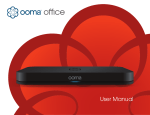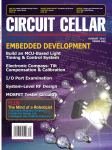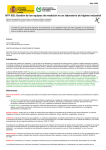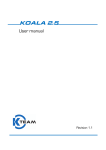Download OmniSound: A 3D Audio System
Transcript
OmniSound Submitted To Gustavo de Veciana Kevin Connor Cisco Prepared By Dalton Altstaetter Marc Hernandez Rounok Joardar Jeffrey Mao Brian Russell Jason Weaver EE464 Senior Design Project Electrical and Computer Engineering Department University of Texas at Austin Fall 2014 CONTENTS FIGURES ..................................................................................................................................... iv EXECUTIVE SUMMARY ........................................................................................................ 1 1.0 INTRODUCTION........................................................................................................... 2 2.0 DESIGN PROBLEM STATEMENT ............................................................................ 2 3.0 4.0 2.1 Problem Definition .............................................................................................. 2 2.2 Specifications ....................................................................................................... 3 DESIGN PROBLEM SOLUTION ................................................................................ 4 3.1 Underlying Theories and Operating Principles ............................................... 4 3.2 Key Decisions ....................................................................................................... 4 DESIGN IMPLIMENTATION .................................................................................... 7 4.1 5.0 LSM9DS0 Sensor ................................................................................................ 7 4.1.1 Configuration ........................................................................................... 8 4.1.2 Calibration................................................................................................ 9 4.1.3 Orientation Calculations.......................................................................... 9 4.2 Integrating Headtracking................................................................................... 10 4.3 Audio Convolution .............................................................................................. 11 4.3.1 GUI ........................................................................................................... 12 4.3.2 Dynamic Filtering .................................................................................... 12 4.4 Latency ................................................................................................................. 13 4.5 Open House Demo............................................................................................... 14 TEST AND EVALUATION .......................................................................................... 14 5.1 Component Testing ............................................................................................. 14 5.2 Subsystems Testing ............................................................................................. 15 5.3 5.2.1 Headtracking ............................................................................................ 15 5.2.2 Audio Filtering ......................................................................................... 17 5.2.3 Subystem Integration ............................................................................... 18 Prototype .............................................................................................................. 18 CONTENTS (Continued) 6.0 7.0 8.0 9.0 TIME AND COST CONSIDERATIONS .................................................................... 21 6.1 Headtracking Delays ........................................................................................... 21 6.2 Headphone Delays............................................................................................... 22 SAFETY AND ETHICAL ASPECTS OF DESIGN ................................................... 22 7.1 Safety Factors ...................................................................................................... 22 7.2 Ethical Issues ....................................................................................................... 23 7.3 Public Interest ..................................................................................................... 23 RECOMMENDATION ................................................................................................. 24 8.1 Alternative Computational Methods................................................................. 24 8.2 Implementing the Gyroscope ............................................................................. 25 8.3 Optimizing Gain .................................................................................................. 25 CONCLUSION ............................................................................................................... 26 REFERENCES ........................................................................................................................... 27 APPENDIX A – OMNISOUND PORTOTYPE ................................................................... A-1 APPENDIX B – USER MANUAL ......................................................................................... B-1 APPENDIX C – BILL OF MATERIALS .............................................................................. C-1 APPENDIX D – GHANTT CHART ...................................................................................... D-1 FIGURES 1. System Accuracy ..................................................................................................................... 16 2. System Deviation ..................................................................................................................... 17 3. System Latency ........................................................................................................................ 19 EXECUTIVE SUMMARY This document discusses Omnisound’s problem statement, design problem solution, design implementation, our testing and evaluation, time and cost considerations, safety and ethical aspects of our design, and our recommendations to improve upon Omnisound. In the design problem statement our team explains how Omnisound will address and assess issues in current binaural audio with headtracking implementations. The biggest issue our team assessed was latency. Creating a system with low latency, high accuracy, low cost, and high portability is highly sought after in the 3D audio field. After researching human auditory perception, our team found that latency exceeding 60 ms, or accuracy exceeding 8.3 degrees, would break the illusion of a 3D audio scene adjusting accordingly to head movement. Omnisound succeeded in its accuracy but exceeded in its latency by 20ms, perceptible to some users. Also in order to create the illusion of 3D audio, Omnisound needed to rotate sound 360 degrees around the users head, which it did successfully. The design solution and the design implementation sections in our report discuss the underlying principles and decisions of creating 3D audio with headtracking. Furthermore, these sections discuss the hardware and software components needed to create 3D audio. The implementation to create 3D audio is to take the head position, use this position to index to a pre recorded Head Related Transfer Functions, HRTFs, and mixes them with an audio source. HRTFs are sounds recorded at multiple positions 1 meter around a Kevlar dummy’s head to simulate how the ear hears sound at different points around the head. To realize our implementation, we used MATLAB to get head position data from our headtracking sensors, index though a library of HRTFs that correspond to the head position, and do real time audio processing that produces audio to the headphones. To ensure that Omnisound addressed our problem statement this document also includes our tests and evaluations that explain our accuracy and latency test results. While our team was testing Omnisound we ensured that our project was in compliance with safety regulations and confirmed that we followed the IEEE Code of Ethics to provide a solution that is beneficial to the publics interest. Upon completing OmniSound our team has recommended alternative implementations to improve our design. The first recommendation would be to use software that can handle real time signal processing, for OmniSound this means not using MATLAB to decrease computational overhead. The second recommendation would be to add a gyroscope in our existing design, this will increase accuracy in headtracking. Finally, our team recommends optimizing the frontal/back gain around the head to create a more immersive 3D audio. 1.0 INTRODUCTION This document describes our team’s efforts in designing OmniSound over the course of the last two semesters. OmniSound is a 3D audio system that incorporates headtracking to generate a highly immersive soundscape. This audio system provides the illusion of natural sounding audio by using 3D audio filtering to add a sense of directionality to the sound and using headtracking to aim that sound at the user. Previous reports have discussed the development of OmniSound in parts. In this report we will cover the full story of OmniSound from start to end, thereby giving any reader a complete understanding of the development of this project. We will begin by describing our initial goals and the requirements and specifications we wanted OmniSound to meet. Then we will discuss the plans and ideas we conceived in order to meet our goals. This will be followed by a detailed, technical look into what we actions we took to make our plans a reality culminating in the final prototype of OmniSound. This section will contain the majority of the work we did in designing our final prototype. We will go over the budget we used and the safety in using OmniSound. Finally we will close with our thoughts on the future of OmniSound. 2.0 DESIGN PROBLEM STATEMENT Before attempting to create a design solution, we needed to have a thorough understanding of our design problem. Additionally, it was important to lay out the goals and specifications we needed OmniSound to meet. Knowing our target parameters and major obstacles, found through research, was crucial to creating a solution that would satisfy the client’s project needs. 2.1 Problem Definition OmniSound aims to improve the quality of stereophonic audio. Stereophonic sound, or stereo, is used to mimic a 3D sound environment. It achieves this by outputting two or more audio channels through different sound filters in order to create an illusion of directionality. When a person moves his head, he changes the direction in which he perceives sound. Current systems have no way to accommodate for this change in positions. Our purpose will be to design a system that can sense a user’s head movement and adjust the audio filters to preserve a more realistic sound environment. This system would greatly improve the audio quality of headphones for a low cost. It would allow for greater distinction between sounds and create a more natural imitation of the soundscape. While the system would be applicable to a number of different scenarios, this project would be most applicable to users in long distance conferences by enhancing the quality of their telecommunications. Other uses might include faster than sound flight, where sounds must be simulated in order to make them audible to pilots. 3D audio also has a place in creating new virtual realities. In any case, creating effective binaural audio gives us innovative new ways to interact with the world around us. 2.2 Specifications Before beginning construction it was important that we identify the parameters and specifications we would need to work around. Though the overall sense of immersion will be subjective there are a number of items that we can standardize to improve the quality of the product across the board. Our primary constraint is latency. Latency is the time between a user’s head movement and the audio output. We found that OmniSound should have a latency of no more than 60ms [4]. Exceeding this bound is highly likely to cause the illusion of 3D audio to dissolve. As a result, this is the utmost priority during construction of OmniSound. We also understood that maintaining a reasonable degree of accuracy would be another key factor. But to discover the exact specifications a very basic idea of how OmniSound would be built was needed. We decided that there would utilize two main components. A system of headtracking and a system of 3D audio generation software. The headtracking system has to be accurate to within 8.3° of the actual angle [2], the minimum angle, indicated by our prior art research, that humans can differentiate different audio positions. Also, to ensure headtracking is minimally intrusive to the user, the headtracking unit cannot weigh more than 20g. The headtracking system must also operate at a voltage of 3.3V, the voltage obtainable from a standard USB port or external batteries [1]. To be easily placed atop a pair of headphones, the sensor board placed on the user’s head must not exceed 1.1" x 1.6" (28 x 41mm) [1]. The 3D audio waveform generation software requires at least a 50 MHz clock speed, which is equitable to existing video communication software [3]. OmniSound must also pass several performance benchmarks. The system response from input to output cannot take more than 60 milliseconds (ms) [4], otherwise, the illusion of 3D audio breaks down. Spatially, OmniSound must simulate an audio source in a specified radius around the user’s head. 3.0 DESIGN PROBLEM SOLUTION Our design solution is composed of a description of the underlying theories that led us to this solution, a summary of the root principles and that form the base functionality of OmniSound, and an outline of how we implemented the solution we came up with, as well as key decisions that shaped the development of OmniSound. 3.1 Underlying Theories and Operating Principles Any solution to our design problem needs to truly simulate 3D sound. That is, it needs to preserve the illusion that sounds are coming from distinct locations around the user, not relative positions that move along with their head. The only way to achieve this illusion without using fixed speakers for each sound source is to modulate each source so that sounds as if it is coming from a fixed position. Since the human brain recognizes the direction a sound is coming from based on how the sound is affected by the shape of the ear, it is possible to simulate sound from an arbitrary point by mimicking the ears’ effects through audio convolution.In order to simulate a fixed point using headphones that rotate with a person’s head, it is necessary to counter this motion by simulating movement of the audio source in the opposite direction by changing the filter the audio is convolved through. 3.2 Key Decisions To accomplish this dynamic audio convolution, or modulation, OmniSound uses a library of HRTFs. The library we used was created by recording the response that microphones in a model of the human head have to sounds at many different angles of azimuth and elevation around the model, and then using an inverse function to determine what filter would have the same effect on an audio sample. Each HRTF maps to a specific point in space around the user. Changing the HRTF changes the perceived sound location. Omnisound works by choosing one of the filters in the HRTF library based on the position of the user’s head and passing a short snippet of the output audio file through the filter. Once a solution is able to simulate an audio source at any location, it needs to be able to determine which location to put each source in real time, so a head mounted solution to our problem would need to be able to somehow track a user’s head movement. In the end, we decided to use a combination of an accelerometer, which can measure changes in angular position relative to gravity, and a magnetometer, which functions similar to a magnetometer by measuring changes in angular position relative to the Earth’s magnetic field. These two sensors combined allow us to track the user’s head along two axes of rotation, which is sufficient to determine an absolute angular position. We considered other options for how our solution would track a user’s head, however. We ultimately decided to use the accelerometer and magnetometer for a few key reasons: neither the accelerometer nor the magnetometer suffer from significant drift in measurement over time like our other considerations, such as a gyroscope. Also, the two sensors are most accurate along different axes, so we are able to accurately cover more angular positions. Early on, we had to make a decision as to whether we would be using a set of sensors mounted on the user’s head (active headtracking) or a software based camera input analysis (passive headtracking). We chose not to use passive headtracking because it would require more complicated software and increase the latency between when the user moved their head and when the system received a measurement. We decided to use active headtracking for these reasons. To implement an active sensor based headtracking system, we needed to make a few key design decisions: what sensor should we use? How would we interface with the sensor? What kind of microcontroller would we need to have as an intermediary between the sensor and computer? What computations if any would need to be done on the microcontroller? These questions have shaped our progress over course of the year. Our two main choices for headtracking sensor were the Razor IMU and the LSM9DSO. The Razor sensor has a built in microcontroller, is only compatible with the I2C communication protocol, and was much more expensive than the LSM8DSO, which is slightly smaller, requires a microcontroller to interface with a computer, and is compatible with both SPI and I2C. So that we could keep our options with regard to the serial protocol we would use open and because it was the cheaper part considering that we already had a microcontroller, we decided to go with the LSM9DOF sensor. To interface with the sensor, we considered using SPI and I2C. The SPI protocol uses more lines than I2C, because each line can only either send or receive data, not both. Because of the simplicity of transfer along each line, SPI is also faster. On the other hand I2C uses fewer lines that can both send and receive data. I2C is slightly slower and more error prone than SPI. These reasons contributed to our decision to use SPI to communicate between our microcontroller and our sensor. As previously stated we already had a microcontroller, which factored into our decision to use the LSM9DSO, and we had no reason to use a different microcontroller since it would only function as an intermediary between our sensor and the computer, so we decided to use our TI LM3S1968. Since we would have a microcontroller between our sensor and computer, we had the opportunity to perform some calculations on the sensor data before it was sent to the computer. We decided to use this opportunity to speed up our calibration process by performing calibration and correcting measurements on our microcontroller. In the process of answering these questions, we developed our plan for implementing the hardware headtracking portion of our design. Once the computer receives the angular measurement from the headtracking module, we needed to use this angle to update the position of the simulated audio source. To make this adjustment, we must read the sensor input from the COM port, and select which HRTF would be the best fit for the angle received. All of these operations could be relatively simply implemented using almost any programming language as a base. The exception is reading the COM port. Most programming languages that our team had experience with have convoluted processes for reading device input, so we decided to use a MATLAB script for the software portion of OmniSound. MATLAB has many built in interfaces for device input as well as audio output, both of which would take additional time designing in most other languages. These benefits, as well as the familiarity our team had with MATLAB led us to choose matlab as our programming platform. This decision was a significant factor in our inability to meet our latency requirements however. The overhead that MATLAB adds to both reading the sensor input and outputting the resultant sound was more than 80% of our final latency. In order to determine which filter would be used at any time in our software we needed to either load in from a file the filter that corresponds to the user's head position or select the appropriate HRTF from a collection of preloaded filters. We decided to load the entire HRTF library into memory at the start of the program to reduce the time spent every time the HRTF is changed at the cost of additional start up time and increased memory usage. In retrospect, our design solution was subjectively successful, with most users reporting a positive experience. However, we didn’t quite meet some of our key product specifications. Our research found that the human ear is unable to detect up to a 60 millisecond latency between the expected sound and when the actual sound occurs. Our solution was only able to reduce our latency to 80 milliseconds. The area in which an alternative solution could have improved this latency the most was in our decision to use MATLAB as the basis for our software portion. Since such a large portion of our latency was caused by MATLAB overhead and the need to reduce the input sample rate in order to achieve an acceptable sound quality. If we had implemented our software module in a lower level programming language we could have significantly reduced our latency at the cost of increased development time. 4.0 DESING IMPLEMENTATION Overall, our design closely followed our Gantt Chart from last semester with some exceptions, see Appendix D. There were several unanticipated design changes that needed to be made during the semester. These changes mainly occurred in the headtracking module. Despite these setbacks, we were able to make up lost time without impacting our projected finish date. 4.1 LSM9DS0 Sensor We made several modifications from our original design and our final implementation. In our subsystem testing, we encountered problems interfacing the LSM9DSO with the LM3S1968 microcontroller using the Serial Peripheral Interface (SPI) protocol. We were not able to debug it directly since it is a clocked protocol and any debugging that interferes with the timing of the protocol will inherently cause errors during data transfer. To fix this problem, we used a digital logic analyzer as our main debugging instrument to view the signals changing so we do not affect the timing. After viewing the timing diagram on the digital logic analyzer, we caught errors in the initialization of the SPI protocol within the microcontroller and changed the clock polarity (CPOL) and clock phase (CPHA) which determine whether the data is latched or read on the rising or falling edge of the clock. This allowed interfacing with the LSM9DSO and we verified communication with the devices by viewing read-only registers with fixed quantities and checked to see that it matched the datasheet specifications. 4.1.1 Configuration Once we were able to communicate with the LSM9DSO the next step was to program it. We initially were going to use the gyroscope and accelerometer for the headtracking. We initialized the LSM9DSO to sample the three gyroscope orientations at an output data rate of 760 Hz and with a cutoff frequency of Fc = 100 Hz [5]. This gives us the most accurate gyroscope information and sets our lower bound of our latency limit at 1/Fc = 10 milliseconds since if we are any faster we will run into the problem of aliasing. The gyroscope range was chosen as + 500 degrees per second (dps), this would be more than enough to detect fast head movements with the best precision since people cannot turn their head even 360 degrees [5]. The next lowest range was + 245 dps which could be insufficient for fast head movements across the full range of head motion [5]. The accelerometer output data rate was sampled at 100 Hz since it has a low frequency response and sampling at higher rates does not add any value and consumes more power. After configuring our settings for the accelerometer and gyroscope we soon found out the difficulty in using a gyroscope because we lacked the ability to verify its accuracy. The 16-bit signed gyroscope measurements have units of change in ADC sample/second ranging from 32768 to 32767. However, since the gyroscope measurements are a function of time, in order to check its values we have to know at what rate the gyroscope is being moved angularly. We did not have an instrument available that rotated at a known radians/second. This presented a significant problem since we chose to use the active sensor and knew that this was possible but were not aware of the additional equipment needed to test it. This was a time consuming setback and required researching other method to determine the elevation and azimuth of the head position. We found a method that used the magnetometer and the accelerometer. Using two absolute coordinate systems also seemed an advantage to using one relative coordinate system and one absolute in terms of reliability testing. The drawback was that magnetometer readings vary depending on the interference that comes from other electronic devices. We used vector calculus equations to re-orient the axes and were able to calculate elevation and azimuth [6]. 4.1.2 Calibration Now that we could get the azimuth and elevation the next step was to calibrate our readings from the LSM9DSO to remove the DC offset. This had to be done for each axis of the accelerometer and magnetometer and is done by taking summing the maximum and the minimum values and dividing by two and adding that to that corresponding axis. We had several problems with our automatic calibration in which we rotated the LSM9DSO around and stored the maximum and minimum values for each axis. this was because of outliers in the sensor readings that can be attributed to noise and time before the sensor settles after being initialized. Our solution to this was to enter the calibration by hand so that those outliers did not skew our reading. This was a time consuming and tedious process prone to human error since it requires someone to observe what the average maximum and minimum values seem to be. This also was inadequate and we went back and modified our original automatic calibration and restricted it to find the maximum and minimum only along fixed axes rather than trying to find them along any orientation. This was much less error prone and helped avoid the previous problem by avoiding outliers since it was moved along a fixed axis which more closely resembles the motion of someone’s head movement and is ideal for system performance on a fixed vertical elevation. 4.1.3 Oreintation Calculations In our initial design we were going to do the calculations for the elevation and azimuth within the microcontroller. Upon implementation on our fixed-point processor, we were using optimized fixed-point operations for square root using Newton’s method, atan2, atan, sine, and cosine. However, we soon ran into problems relating to overflow, correct scaling of data before calculations, and rounding resulting from truncation. Our initial reasoning was that using fixedpoint operations would drastically reduce latency over a floating-point representation. On the contrary, there were many bugs associated causing the microcontroller to become stuck in infinite loops due to overflow and underflow. If we were conservative on our estimates then we would not be using our full range of 32-bit values effectively and would lose a significant amount of precision. On the other hand, the greater range of values we used the greater chance of overflow. This was complicated by the doing multiplication of 16-bit numbers which already maxes out our full 32-bit range and guarantees loss of precision. As the number of calculations compound, more precision is lost along the way. Our initial idea was to send the elevation and azimuth to MATLAB to be processed. We soon found this to be a task unsuited to a general purpose microcontroller limited to a fixed-point processor. We reasoned that since there would need to be communication with MATLAB that we would do all the processing in MATLAB using double-precision. We concluded that we would have more computation power using a PC for the calculations that the trade-off between fixed-point and floating-point would be nominal at least and, potentially, performance enhancing at best. At that point we determined to use the microcontroller as a debugging and polling instrument to gather accelerometer and magnetometer data and send the raw data directly to MATLAB. 4.2 Integrating Headtracking Integrating the headtracking data with the MATLAB filtering module came with its own issues with data transfer. We used the Universal Asynchronous Receive Transmit (UART) which sent bits, clocked serially, at baud rate 9600 bits per second. This baud rate was initially much higher in testing but was modified after making the final prototype. A higher baud rate reduces latency but the signal degraded severely in our 10 ft ribbon cable. The microcontroller is constantly sampling the LSM9DSO and always has the most recent headtracking data. In our initial implementation we were constantly sending the headtracking through the UART even if we were not reading the data into MATLAB. We thought this would speed up a transmission since all that was necessary was to open the receiving side of the UART in MATLAB. However, we quickly discovered what we thought were incomplete data transmissions. We learned that when we opened the UART port in MATLAB, our first byte we would get would arrive somewhere in the middle of a data transmission. To fix this problem, we no longer would continuously transmit data from the microcontroller, but would instead only transmit the data on request. Before each read, the microcontroller would poll the UART to see if a UART transmission was requested. If a transmission is requested, it would transmit the current data and then assume the normal execution path of reading the headtracking data. Although this increased the latency, this allowed us to guarantee the order in which we receive the data without having to modify the transmission to tell different data transmissions apart from one another. 4.3 Audio Convolution The filtering subsystem convolved the input audio with the Head Related Transfer Function (HRTF) to create binaural (directional) audio. We first started with binaural audio in a static environment where the direction of the audio was pre-determined by us in our MATLAB script. Our first goal, was to test the extremes filtering with the HRTF coefficients for +90 and -90 degrees. This proved successful, and we soon sought to change the source position rather than having a fixed direction for the sound clip. We created a sound file in which we had the source move a full 360 degrees around the user’s head in 15 degree movements. However, we noticed the audio quality decreased during the process and heard intermittent “popping” indicating when we switched HRTF filters. We discovered a couple reasons for this. We hypothesized that the using HRTF filters with a precision of 15 degrees was too large. We found there were other HRTF filters that had precision of 5 degrees and used these in place of the original filters. There was no discernable difference when comparing the audio when using the higher resolution HRTF filters. This led us to believe the problem was related to using the MATLAB function convolve which spreads the spectrum of the audio to n+m-1 where n is the number of audio samples being convolved and m is the number of HRTF filter coefficients used in the FIR filter. Increasing the number of samples changes the frequency of the audio due to the group delay of the filter. By doing this on each audio frame being filtered we were modifying the audio and reducing the quality. To resolve this, we used MATLAB’s filter function, which returns the same number of output samples as there are in the input samples. This greatly reduced the level of popping but did not get rid of it completely. It was not until we consulted Dr. Brian Evans that we realized we should have been saving the output filter coefficients from each filtering operation to use as inputs for the next HRTF filter. This solution eliminated all audible “popping.” Now, we had a stand-alone prototype simulation for an ideal case when there is no latency associated with acquiring the headtracking position. We would use this as a template for the dynamic filtering. 4.3.1 GUI Before we can implement our dynamic filtering we first had to build a simple interface with which a user could interact with our software. To achieve this we made a Graphical User Interface (GUI). The goal of the GUI is to initialize the processes required to run our system. The GUI accomplishes two main tasks: 1) taking the path to the HRTF filter library and reading the filter coefficients into MATLAB. 2) Selecting the audio file the user want to use as the audio input. We give the user some freedom in steps 1) and 2) therefore stringent error testing was done to assure that the user selected the correct folders for the HRTF library and that the user, did in fact, select a valid audio file. If these assumptions were not met the project would wait until it has the valid HRTF libraries and an audio file. Once it has these two valid inputs, It would call the dynamic filtering script which would run the system. 4.3.2 Dynamic Filtering In building the dynamic filtering we realized MATLAB’s deficiencies in implementing a realtime audio system. The tools that worked well for our original static simulation were not available in the dynamic system. The dynamic filtering required changing three main parameters associated with playing the audio through the computer’s sound card. Of these three parameters there is only one independent parameter, with the other two being dependent on other variables. The first (independent) parameter was the time per frame. Filtering the audio dynamically requires break the input audio file into frames. The number of samples in a frame is dependent on the time per frame. Since our sample rate is CD quality of 44.1 kHz the number of samples can be calculated by (44100 samples/second) * (X seconds/frame) = 44100 * X samples/frame. The next (dependent) parameter is the sample rate and is fixed based on the audio. As previously noted, our sample rate was 44.1 kHz. The final (dependent) parameter is the number of samples per frame, which was calculated above as 44100 * X, where X is defined as the number seconds/frame. To understand how to optimize our one independent parameter it required understanding how MATLAB interfaced with the computer’s sound card on a hardware level. The MATLAB documentation used a queue to store the audio samples. The time per frame determined the size of the queue [Matlab documentation backing this up]. If we failed to allocate a large enough queue we ran into underrun problems and our output audio wouldn’t play from the sound card. If we allocated too many samples the latency performance was unacceptable and did not meet our 60 ms latency upper bound. This required a significant amount of time to find the optimal trade-off between low latency audio and audio quality. One way we reduced the latency was to truncate the HRTF filters from 512 coefficients to 256 coefficients. This would speed up our on-going calculations being computed while the last frame was playing through the sound card. Our latency requires the time per frame to always be less than the filter computation time. this is because these operations are being done in parallel and if our sound card is finished playing the audio before we have put the next frame into the queue, then we get the queue underrun warning since MATLAB is attempting to play audio that has not yet been sent to the queue and the sound card outputs noise until the next frame is loaded into the queue within the time specified in time per frame, which may carry over for several seconds of audio, not just the next frame. This details the importance of correctly selecting the time per frame since it has a ripple effect that may last for up to several hundred frames and seconds of audio. 4.4 Latency The bottleneck of the latency occurred in the first transmission of the queue to the sound card. This characterized the lower bound for all other transmissions and determined how far behind in time our most recent headtracking coordinates were. The calculation time for filtering was on the order of tens of milliseconds and the queue latency was in the range of 30 to 50 ms to transfer the audio to the sound card. One solution we found to reduce latency, on a hardware level was use sound card drivers that interface directly with the sound card hardware, bypassing the windows drivers. These drivers were called ASIO4ALL. There was potential for these drivers to work too well, in which the latency was so low that we would not be able to finish the filter computations before a new frame was being output to the sound card and another queue underrun would occur. When testing the ASIO4ALL drivers we immediately got the queue underrun warning and heard the “popping” associated with underrun. This was expected and verified the latency reduction when bypassing the windows sound card drivers. This had the effect of reducing latency after exhausting other methods of optimization through software. 4.5 Open House Demo Our final task was to determine how to best demonstrate our working prototype at Open House. This was something we had thought about months in advance of Open House since it could change the design depending on the features we chose to focus our demo on. One idea was to place several directional audio sources in space with the sound sources being at fixed angles relative to the each other but with the user’s head being relative to all the sources. Implications of this include moving the sound sources around the user’s head but keeping the sound sources all coming in at a different direction as perceived by the user. This is the embodiment of our project since this would all be done in real-time and would accurately simulate what someone would hear in a normal soundscape with authentic sounds as opposed to our simulated audio. This idea seemed promising since it exemplified the design problem our project intended to solve. To our dismay, when we tested it, the audio was overwhelming to the extent that it was detrimental to the illusion of binaural audio and did not naturally replicate what a person would hear in a soundscape. In effect, we simplified our dynamic demo to play a single directional sound to demonstrate the effectiveness of our design without overwhelming the user. In conjunction with our dynamic filtering demo, we had our static demo available for people to listen to. This was our initial simulation that played an audio file from 0 to 360 degrees and showed how the concept was effective in an ideal situation. The goal of our demo was to educate people about binaural audio and based on the responses at open house the feedback was overwhelmingly positive. 5.0 TEST AND EVALUATION To verify Omnisound we tested it at the component, subsystem, and prototype level. Overall, our testing focuses on the latency, accuracy, and the listener's perception of the system. For more background information on our testing plan, refer back to our previous Testing and Evaluation Plan. 5.1 Component Testing When we began constructing our head tracking system, we tested the individual components as we received them to avoid possible defects later in the process when they could be more costly. Omnisound utilizes three different components: the sensor (LSM9D0 breakout board), the microcontroller (LM3S1968), and a pair of over-ear headphones. We first confirmed the sensor and microcontroller were working. We conducted two yes/no tests that checked whether we could download code into the microcontroller and whether the UART could send/receive data. Both tests were successful. We then tested that the sensor generally measured the magnetometer’s north heading and the accelerometer’s gravity heading. It is impossible to unmarry our interpretation and calibration of the sensors data from the sensors themselves. Thus at the component level, it is sufficient to know that they pointing in a direction. Our headphone tests were also successful. We qualitatively decided that the headphones had a standard balance and sufficient noise isolating for open house. No malfunctions arose, but we had duplicates of all physical components for any unforeseen circumstances. Having run these tests, we are confident that all physical components are functioning properly. 5.2 Subsystems Testing Omnisound has 2 subsystems (shown in Figure 1): headtracking and audio filtering. Both systems are closely integrated, so we tested both that the two major subsystems worked individually and successfully with each other. 5.2.1 Headtracking First we measured the accuracy of our computed angles from the actual angles. To do so, we followed the following procedure. First, we labeled a polar grid like the one shown below. Next, we laid the polar grid parallel to ground. Third, we moved the sensor to point at label 1 330 degree. Fourth, we looked azimuth read by the sensor. We then recorded this data on a graph, and repeated the process 12 more times for test points 1 through 12. Figure 1. System Accuracy Based on Experimental results, our head tracking system is reasonably accurate. However, the error of our headtracking unit seems to increase the further we go away from the original point of measure. This is because the headtracking unit reorients everything based on an initial starting vector front. The further one goes away from front the larger the error becomes hence why 5 and 6 which are the back of the head have the worst accuracy. This is within our accuracy limit; because, the human head can only turn itself 90 degrees right or 90 degrees left meaning only test points: 9,10,11,12,1,2, and 3 are really going to be useful. We then measured how much Omnisound deviates from a value by collecting values when our prototype was stationary. The average deviation of the elevation was 1.528 degrees. As our HRTF library is incremented every 10 degrees in the elevation direction, that standard deviation is well within acceptable limits. We then leave the sensor on in the same position for 15 minutes to see the drift of values along init. As long as our drift is under 8.3 degrees, we will accept our values as consistent. Now consider the deviation of the azimuth shown in Figure 2. The Purple Line represents our experimental deviation of azimuthal values for different Elevations. The yellow line represents the accuracy at which the error becomes perceptible to the human ear, 8.3 degrees [2]. The Red Line represents our ideal standard deviation, half of the azimuthal precision for a given elevation. For all variance below the red line, it will not improve our sound quality any noticeable amount. Figure 2. System Deviation You can see from the graph that the further away the elevation is from level (0 degrees), the higher our deviation. What you can also see is that because the HRTF library resembles a sphere, the azimuthal distance also increases the further away from level (ex: 90 degrees elevation rounds all azimuths to a single point). Thus our experimental line is almost completely within our ideal variance, and it is well below what is perceptible to the human ear. Thus Omnisound is acceptably consistent. 5.2.2 Audio Filtering We first tested the audio file and head angle that is the user input. After presenting the midsemester Oral Progress Report, our corporate sponsor from Cisco clarified that Omnisound doesn’t need to support different inputs and platforms. Thus we only verified valid audio file paths for .mp3 and .wav. We then ensured OmniSound rounds head angles correctly to chooses the closest HRTF filter. Note that users input their head angle by their head and not a GUI. We automated a test that sequentially cycled through every combination of elevation (-40 to +90 degrees) and azimuth (0 to 360 degrees). It confirmed that a file was found for every combination, and it ensured that the difference between each input and result was no more than ceiling(input) / 2, choosing the closest HRTF. Even though we were then sure Omnisound was rounding to the nearest HRTF correctly, we conducted preliminary tests by typing an angle into a GUI and having the user guess the location. We had a perfect general localization except when the HRTF was directly in front or behind the user. The result was not surprising as it is a flaw of the human ear. 5.2.3 Subystem Integration We then tested that the UART was correctly transmitting data. The test continually sent a stream of consecutive numbers from the microcontroller. Then computer input a set of consecutive numbers and checked to see if MATLAB head read the same set. The success of the test ensures that the UART correctly transmitted the data without introducing any error or losing data. We also tested latency of this component and the microcontroller at a baud rate of 9600 bits per second. Everything from reading the sensor to sending the data to MATLAB takes no more than 2 ms. 5.3 Prototype Once the prototype was complete, we began testing the latency of the full system. This was done using MATLAB’s internal time profiling functions and users’ judgement. We recorded the latency of 25 audio steps at the component level. Figure 3 represents these latencies after we took the rounded ceiling after throwing out the outliers. Figure 3. System Latency The two biggest latencies are retrieving the angle from the microcontroller (18ms = 22.5%) and outputting the audio to the computer (46 ms = 57.5%). Even though the microcontroller can transmit everything in under 2 ms, the MATLAB input/output overhead increases the latency to an irreducible 18 ms. The output deals with the same MATLAB input/output overhead. MATLAB pushes the audio section to a buffer, and the computer comes and pushes it to the headphones. Even with decreasing the buffer and accurately syncing when the computer wipes the buffer with when the buffer is written to (both functions of the size of the audio sample) the component latency was over half of the whole latency. Originally we estimated that the filtering (5 ms = 6.25%) would be a big factor, and we had ways of truncating the process, but they proved insignificant comparatively. We previously defined success to be if on average the difference between requesting the raw data from the sensor and outputting the audio out is less than 60ms. The components of Figure 3 equate to 71 ms. What’s more, is that when audibly tested by users, we found 80 ms to be the minimum acceptable latency. Why? Real-time processing is simply being able to compute and output a sample in less time than the sample takes to play. When the sample takes less time than everything else, small gaps or pops happen in the audio. We attribute the extra 9 ms (actual latency - measure latency) to outliers that sometimes take longer than measured and the time the audio takes to be read from the buffer and output into the user’s headphones. Omnisound also met the required specifications that didn’t need tests. First it met the weight requirement. The sensor only weighs 2.3g and even with the ribbon wire it is far below the 20g limit. The small board is also within the size specification and fit neatly on the headphone band. Also, all of the hardware was run off of a single USB port. Lastly our system did replicate a sound environment at a radius around the user’s head, but not with complete success. Many users claimed that the sounds sounded very close to the instead of at a 1m distance. We believe this to be a limitation of the HRTF library that we chose. Lastly, we tested Omnisound with some members of other groups in our Senior Design lab and presented it at the open house with this accuracy, deviation, and latency. We previously put numbers and percentages on how we would deem accuracy sufficient, but they did not work in practice. Pointing was much more practical to identify a spherical direction, and all users were able to locate the position of the “stationary” sound. Again, we experienced some confusion directly in front and behind the user, but it was expected. In this we said the accuracy and deviation were sufficient. Next, we already knew Omnisound was 20 ms longer than our research said was perceptible, but we wanted to know if it was perceptible in our tests. No one on our team could detect the delay unless we thrashed out heads back and forth, and only two people at the entire open house mentioned hearing a delay. Note that it is probable that more people heard the delay, but did not voice it. In this we said that we did fall short of the latency requirement, but it would not be that detrimental or noticeable in regular use such as in a conference call. Overall it is important to note that most users reported a positive user experience. 6.0 TIME AND COSTS CONSIDEATIONS We successfully met our time and budget constraints. Although there were some implementation setbacks, Omnisound was completed within our time constraint. Budget was never an issue for OmniSound; because, our implementation is cheap easily under $300, see. The two main setbacks we faced were implementing our headtracking module and our headphones arriving later than expected. 6.1 Headtracking Delay When implementing our headtracking module we found that the accelerometer and the gyroscope pair was insufficient for calculating azimuth. The accelerometer can not help compensate for the natural drift of the gyroscope along the XY plane; because, the accelerometer only naturally senses gravity which points down in the Z vector. Without an X or Y reference vector, the gyroscope will uncontrollably drift way off target for in intervals of time as short as one second. As a result, we moved toward the magnetometers, which has an XY reference vector, magnetic north. Marc, Jeffrey, and Dalton focused on implementing the new headtracking design while the rest of the team remained focused on convoluting the HRTF functions in MATLAB. This delayed our headtracking completion by half a week. The LSM9DS0 included a magnetometer attached, so we did not need to order new parts. This allowed our team to reuse most of the old gyroscope code in the new configuration. Once we implemented the magnetometer , we realized that the measurements lose a lot of accuracy when the head tilts up and down. Marc and Jeffrey then had to research methods to compensate for the tilt. Jeffrey came up with a solution in three days. We used the accelerometer to calculate the users position in the up and down direction and used that angle to compensate reorient the magnetometer’s azimuth. This solution did not have the drift of the old solution, and could handle the tilt fairly well within a reasonable range. Because our accelerometer was already implemented, we were able to successfully implement the formula’s within one day. All together, we were able to minimize the time lost from researching and implementing the solution to one week. However this change ran us into another problem, the electronic magnetometer needs calibration. We had to spend another week developing automated calibration software to smooth the set up process. Altogether, our schedule was pushed back two weeks from our planned schedule, we compensated for the lost time by cutting our user testing period short. Thankfully, the use case studies, we did do were mostly positive, and we feel that we did not lose too much data from cutting our testing time. 6.2 Headphone Delay We ordered the headphones earlier than we needed to in case the the order should take take longer than expected. However, our headphones managed to take longer than we thought it would. In fact, they arrived in the middle of November. Our team was able to get around this delay by testing the headtracking module on our personal headphones. This allowed us to complete most of the testing before our ordered headphones arrived. Afterwards, we constructed the fully working prototype and test it in one day. As a result, we were not delayed and completed our headtracking module on schedule. 7.0 SAFETY AND ETHICAL ASPECTS OF DESIGN Omnisound adheres to safety and ethical standards that protect the the public's interests. The safety and ethical standards are set to protect the user from injury and the environment by properly disposing the electrical components used in Omnisound, if need be. 7.1 Safety Factors During Omnisounds implementation, many safety factors were considered in order to protect the user from being injured. Omnisound is constructed with over the ear headphones, a microcontroller, and a headtracking sensor. The headphones consist of a cable, two speakers, a headband, and ear pads. The the wires within the cable are covered by insulation that protects the user from being shocked when the earphones are plugged into the computer. The volume at which the speakers produce sound is controlled by the user. The Occupational Safety and Health Administration,OSHA, recommends to the general public to keep volume levels below 85decibels, this is equivalent to a running lawnmower [7]. The headband, that presses the speakers against the users ears, are built to fit various head sizes. To ensure that the headband is not uncomfortable, many headphone users stretch the headband on an object that is equivalent to the users head size [8]. The ear pads are used to separate the metal plating from the speakers from the users head. Furthermore, the ear pads increases comfort for the user. To protect the user from the exposed microcontroller and the exposed sensor our team has covered the headtracking sensor with insulation tape and placed the microcontroller in a plastic container. The microcontroller possesses exposed pins that connect to the headtracking sensor. Our microcontroller operates at 3.3 V and 4 milliamps [9]. According to OSHA 4 milliamps is safe for operation [10]. Should the user should come in contact with the exposed microcontroller while using Omnisound, he or she will feel a faint tingle at the touch [11]. Similarly, the headtracking sensor operates at 3.3 V and 4 milliamps. The headtracking sensor has exposed solderings that at the touch can cause a faint tingle at the touch. So to ensure the users safety, our team has covered the exposed soldered wires attached to the microcontroller with insulation shrink wrap and covered the headtracking sensor with insulation tape. 7.2 Ethical Issues Omnisound follows accordingly with the IEEE code of ethics.The ethical standards, from the IEEE code of ethics, that are most relevant to Omnisound are 1, 3, 5, and 6 [11]. According to IEEE ethic code 1, our team was responsible in keeping Omnisound consistent with the safety, health, welfare of the public, and the environment. The Safety Factors section discuss all possible components that could injure the user and how our team has taken precautions to prevent user injury. To protect the environment Omnisound was built with components that are easy to dispose of that will not harm the environment. All of the results presented in this document, and presented to stakeholders, are honest and realistic in stating claims or estimates based on available data [11]. Omnisound follows IEEE ethic codes 5, and 6 because the purpose of constructing this project was to improve understanding of 3D audio with headtracking technology with low-latency. This project contributes to in the public's increasing interest in 3D audio for video game applications and video conferencing. 7.3 Public Interest Omnisound serves the public's interest and humanity. This project serves the public's interest and humanity because this project demonstrates that someone that is unfamiliar with 3D audio can purchase the same hardware and use the same open source code to further their understanding of latency with 3D audio and headtracking. Since Omnisound is open source, people can replicate our results, improve our system, and find other methods of lowering latency in 3D audio with headtracking systems. 3D audio with headtracking is becoming increasingly prevalent and more projects similar to Omnisound will be built to contribute to the publics interest in 3D audio applications. 8.0 RECOMMENDATIONS Overall, OmniSound is a successfully finished design;however, if we were given the chance to improve on it, we could see several possible avenues. The three main areas of improvement we could take would be: moving away from Matlab to decrease computational overhead, incorporating a gyroscope into our design, or optimizing the frontal/back gain around the head. We feel like each of these changes could significantly improve the OmniSound experience. 8.1 Alternative Computational Methods First, we would recommend migrating away from Matlab.One solution would be to migrate all the computations on to the microcontroller. This would require changing to a microcontroller to one that could perform floating point operations and could interface with a DSP. The DSP is optimized for mathematical calculations meant for filtering. Combining a DSP with a powerful general purpose microcontroller would reduce the amount of overhead required for the user and get rid of the need for an expensive commercial license of MATLAB. This would change a division of tasks in subsystem. The microcontroller would then be used as a control unit for initialization and intermediate instructions. In parallel, the DSP would calculate the azimuth and elevation angles and then filter the audio source in real time. Instead of requiring a computer, we could send our audio output to a high-speed Digital-to-Analog Converter (DAC) and then attach the DAC to a stereo headphone jack. The benefits associated with this approach would get rid of any need to interface with an external computer and would allow the project to be completely self-contained. This would also removing the latency associated with interfacing between MATLAB and the microcontroller. Drawbacks to this method require a microcontroller and DSP with large enough memory capacity to store the audio samples and the HRTF Library, the power consumption would intrinsically increase due to the increased performance requirements and need to power both a microcontroller and a DSP along with a high-speed DAC. Another drawback would be that the size and cost of the project would increase due to needing more hardware and a high performance necessary for a real-time system application where latency has already been defined the critical issue. Also, the testability of this design would require constant use of an oscilloscope and digital logic analyzer to verify proper operation. Ultimately, this would be a more robust and portable design at the cost of placing more requirements on the hardware. An alternative approach would be to write a C or C++ program that would interface with the computer and microcontroller to poll data from the microcontroller and perform the computation in the C program taking place within the computer. C being a lower level language runs up to ten times faster than Matlab and Java; however, there would still be a small overhead present when performing the operations. The main advantage of this approach of the microcontroller is that the computer has much more memory and debugging tools than any microcontroller. This advantage allows for longer sound files to be played and for an easier development cycle at the price of a speed. This opens up the possibility for future study to find the better solution. 8.2 Implementing Gyroscope Another avenue of improvement we would recommend is adding a third gyroscopic sensor. We did not have the equipment necessary to test the gyroscope in our project therefore had could not implement it. In theory, if we add a Complimentary filter with the gyroscope and our original computation done in our design implementation plan, it should improve the accuracy of our headtracking module greatly, and reduce the error incurred from tilt. The greatest problem our headtracking module faces is when it experiences a large amount of up and down tilt, so adding the gyroscope should alleviate most of these problems. 8.3 Optimizing Gain Finally, finding the optimal response for the frontal and back audio gains would increase the binaural audio illusion. One of the problems with the HRTF is that it does not simulate the frontal sounds very well. One simple solution is to add a gain for sounds in the front to simulate real life better. This would require a much larger user case study than the one we performed to optimize the coefficients for the front coefficients for a good population people; however, we are confident that it would improve the audio experience. 9.0 Conclusion Over the last two semesters, our team designed and constructed OmniSound, a system of 3D audio that incorporates low latency headtracking. The final prototype utilized a combination of accelerometer and magnetometer to provide accurate and timely headtracking. A MATLAB software that we created uses HRTF filters along with the aforementioned headtracking data to add the illusion of 3D direction to the output audio. Combining these two systems results in a soundscape that reacts naturally to the user’s head movements. The whole process is carried out with low latency in order to preserve the illusion of 3D audio. This project was carried out within our time constraints and well under budget and had no safety or ethical concerns. This technology can be applied to improving business telecommunications, and in there is future work available integrating OmniSound with teleconferencing software. In the future, we also advise moving the software components out of MATLAB to reduce latency. Using a gyroscope to improve the accuracy and optimizing gain to refine the illusion of 3D audio. These changes would be important to fully market OmniSound. At this juncture OmniSound clearly demonstrates the ability to create an immersive 3D soundscape that adapts to the users head movements. REFERENCES [1] L. A. Ludovico, D. A. Mauro, D. Pizzamiglio. (2010). Head In Space: A Head-Tracking Based Binaural Spatialization System [Online]. Available: http://www.ludovico.net/download/papers/SMC2010.pdf [April 13, 2014]. [2] A. D. Musicant, D. R. Perrott, " Minimum auditory movement angle: Binaural localization of moving sound sources," The Journal of the Acoustical Society of America, vol. 62, no. 6, pp. 1463, 1977. [3] D. Yang (2004, Dec.). 3D Sound Synthesis using the Head Related Transfer Function [Online]. Available: http://trace.tennessee.edu/cgi/viewcontent.cgi?article=3597&context=utk_gradthes [April 19, 2014]. [4] 9 Degrees of Freedom - Razor IMU, SparkFun Electronics, 2014; https://www.sparkfun.com/products/10736 [5] Stmicroelectronics. "INEMO Inertial Module: 3D Accelerometer, 3D Gyroscope, 3D Magnetometer." (n.d.): n. pag. Adafruit. Web. 24 Nov. 2014. <http://www.adafruit.com/datasheets/LSM9DS0.pdf>. [6] Semiconductor, Inc. Freescale. "Roll, Pitch, Yaw Equations." AN4248, Implementing a TiltCompensated ECompass Using Accelerometer and Magnetometer Sensors - Application Notes (n.d.): n. pag. Web. 25 Nov. 2014. <http://cache.freescale.com/files/sensors/doc/app_note/AN4248.pdf>. [7] "OSHA Rules on Earphones." Business & Entrepreneurship. N.p., n.d. Web. 26 Nov. 2014. <http://yourbusiness.azcentral.com/osha-rules-earphones-14271.html>. [8] "Make Your Tight, Brain-Squeezing Headphones More Comfortable with These DIY Tricks." Lifehacker. N.p., n.d. Web. 27 Nov. 2014. <http://lifehacker.com/5886125/make-yourtight-brain-squeezing-headphones-more-comfortable-with-these-diy-tricks>. [9] [Spms037G, Texas Instruments Incorporated, and ]. "LM3S1968 Evaluation Board." (n.d.): n. pag. Texas Instruments. Web. 25 Nov. 2014. <http://www.ti.com/lit/ds/spms037g/spms037g.pdf>. [10] "Controlling Electrical Hazards." Controlling Electrical Hazards. N.p., n.d. Web. 27 Nov. 2014. <https://www.osha.gov/Publications/3075.html>. [11] "IEEE Code of Ethics." IEEE. N.p., n.d. Web. 25 Nov. 2014. <http://www.ieee.org/about/corporate/governance/p7-8.html>. APPENDIX A – OMNISOUND PROTOTYPE APPENDIX A – OMNISOUND PROTOTYPE OmniSound Prototype APPENDIX A – OMNISOUND PROTOTYPE OmniSound Flow chart APPENDIX B – USER MANUAL APPENDIX B – USER MANUAL INSTUCTIONS TO OPERATING OMNISOUND: 1. Plug in the USB, from the microcontroller, into the computer. This turns Omnisound on. 2. Plug in the headphones into the audio jack. 3. Calibrate the LSM9DOF sensor by rotating the headphones 360 degrees in the azimuth direction and press select on the microcontroller. Then, rotate the headphones in the forward direction 360 degrees and press select. 4. Turn on MATLAB, and load the source code. 5.Select ‘RUN’ ounce source code is properly loaded. 6. The GUI will prompt the user to select an audio file. (Rooster, gunshot, saxophone) 7.Select ‘Play’ in the GUI. 8. When sound is present, begin turning head. * 9. To turn off Omnisound simply press ‘Stop’ in MATLAB. From here you can run the code again and pick different audio file or shut down MATLAB. *Be aware of headphone volume. To ensure that volume levels are tolerable, begin with low levels of volume then increase the volume level as needed . APPENDIX C – BILL OF MATERIALS APPENDIX C – BILL OF MATERIALS Component Description Quantity Total Cost TI LM3S1968 Microcontroller to convert raw data from sensor into position data 2 $80.00 LSM9DOF Sensor board that combines a gyroscope and accelerometer 2 $30.00 Headphones Our prototype requires a pair of headphones with a reasonably large band to hold our sensor board 1 $60.00 Personal Computer OmniSound will require the use of a computer N/A NA Ribbon Wire Needed to connect off-board microcontroller to the LSM9DOF 10 ft $10.00 Total Cost $280.00 APPENDIX D – GHANTT CHART APPENDIX D – GHANTT CHART ID Critical Path: Milestones: Tasks: Task Name Project Schedule 5 Construct User Interface 3 Construct 3D Audio Composition Subsystem Construct Headtracking Subsystem 10/31/2014 11/5/2014 All 10/17/2014 10/30/2014 All 10/17/2014 11/6/2014 10/15/2014 10/15/2014 All 10/9/2014 10/14/2014 All 9/8/2014 9/8/2014 9/8/2014 10/8/2014 BR, JW 10/8/2014 JM, DA 9/15/2014 MH, RJ 8/28/2014 9/5/2014 MH, RJ 9/8/2014 10/16/2014 1d 4d 10d 15d 1d 4d 23d 23d 6d 7d 29d People Duration Technical Performance 6 Assessment of Subsystems 11/5/2014 All 19d Finish 7 Pre-Demo subsystems 4 Technical Preformance of integrated system 11/5/2014 12/3/2014 All Start 10 Final Demo of integrated system 11/7/2014 1 Phase I: Ordering Parts 2 Phase II: Implementation 11 Phase IV: Finalize documentation 1d 9 Integrate all Subsytems Phase III: Subsystem Integration 12 Present OmniSound at Open 11/24/2014 11/24/2014 All House 8 13 Sep 2014 9/7 Oct 2014 Nov 2014









































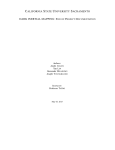
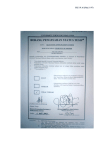
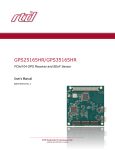


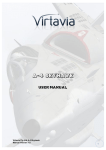

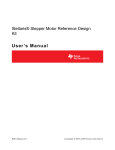
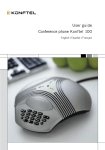
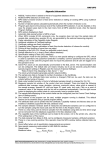

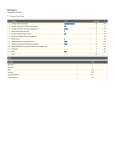
![Audio Extremes Entertainment [Graffiti Spray User Manual]](http://vs1.manualzilla.com/store/data/005858722_1-74e7fc11dae975c9529a69c83302f350-150x150.png)
